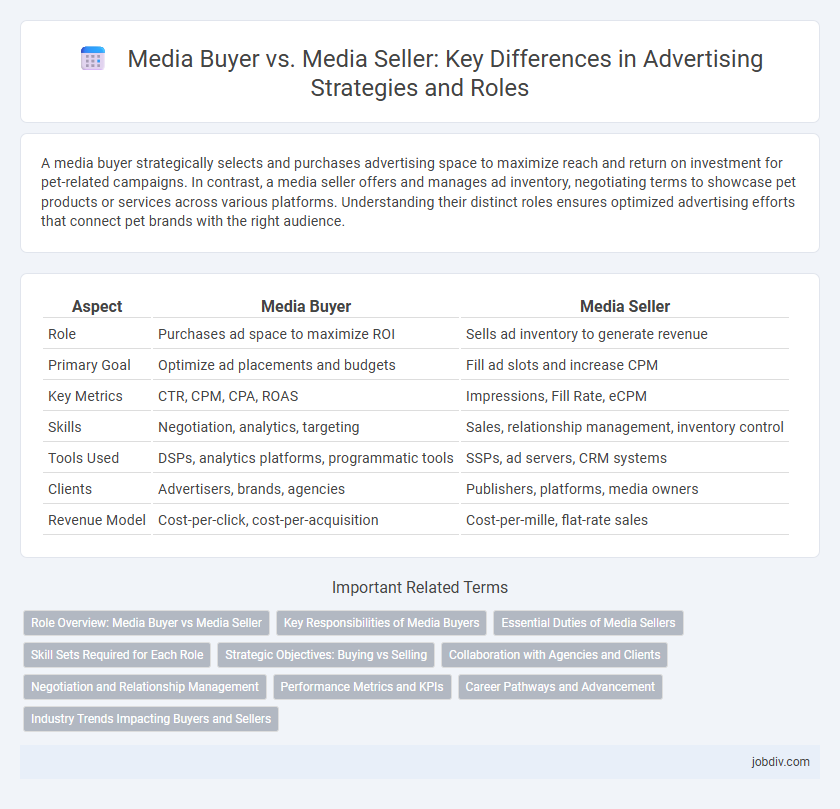A media buyer strategically selects and purchases advertising space to maximize reach and return on investment for pet-related campaigns. In contrast, a media seller offers and manages ad inventory, negotiating terms to showcase pet products or services across various platforms. Understanding their distinct roles ensures optimized advertising efforts that connect pet brands with the right audience.
Table of Comparison
| Aspect | Media Buyer | Media Seller |
|---|---|---|
| Role | Purchases ad space to maximize ROI | Sells ad inventory to generate revenue |
| Primary Goal | Optimize ad placements and budgets | Fill ad slots and increase CPM |
| Key Metrics | CTR, CPM, CPA, ROAS | Impressions, Fill Rate, eCPM |
| Skills | Negotiation, analytics, targeting | Sales, relationship management, inventory control |
| Tools Used | DSPs, analytics platforms, programmatic tools | SSPs, ad servers, CRM systems |
| Clients | Advertisers, brands, agencies | Publishers, platforms, media owners |
| Revenue Model | Cost-per-click, cost-per-acquisition | Cost-per-mille, flat-rate sales |
Role Overview: Media Buyer vs Media Seller
Media Buyers strategize and purchase ad space to maximize ROI for clients by analyzing target audience data and selecting optimal platforms. Media Sellers manage inventory and negotiate sales to advertisers, ensuring high fill rates and revenue for publishers. Both roles require deep knowledge of market trends, audience insights, and effective communication to meet business objectives.
Key Responsibilities of Media Buyers
Media buyers are responsible for researching target audiences, negotiating ad space or time across digital, print, and broadcast channels, and optimizing campaigns to maximize return on investment (ROI). They analyze market trends and performance metrics to adjust strategies for effective audience reach and budget allocation. Media buyers collaborate closely with media sellers to secure competitive rates and ensure placements align with client objectives.
Essential Duties of Media Sellers
Media sellers are responsible for inventory management, negotiating ad placements, and optimizing media space to maximize revenue for publishers. They collaborate with advertisers and media buyers to tailor advertising packages that meet campaign goals while ensuring efficient use of available media channels. Effective media sellers leverage data analytics to track performance metrics, adjust pricing strategies, and enhance overall media inventory profitability.
Skill Sets Required for Each Role
Media Buyers require expertise in data analysis, audience targeting, and negotiation skills to optimize ad placements and maximize return on investment. Media Sellers need strong communication, relationship-building abilities, and persuasion skills to effectively pitch advertising space and close deals with clients. Both roles demand a deep understanding of digital marketing platforms, media planning, and industry trends to drive successful advertising campaigns.
Strategic Objectives: Buying vs Selling
Media buyers prioritize optimizing ad placements to achieve client campaign goals such as maximizing reach, engagement, and ROI within specific budgets. Media sellers focus on inventory management, pricing strategies, and audience targeting to maximize revenue from available advertising spaces. Both roles align strategically by balancing demand and supply to ensure efficient market transactions and successful ad campaign outcomes.
Collaboration with Agencies and Clients
Media buyers collaborate closely with agencies and clients to strategize and purchase optimal advertising slots, ensuring targeted campaign delivery. Media sellers provide inventory access and negotiate terms with agencies, facilitating smooth ad placement across platforms. Effective collaboration between media buyers and sellers enhances campaign efficiency, driving better ROI for clients.
Negotiation and Relationship Management
Media buyers excel in negotiation by securing optimal ad placements and pricing through data-driven strategies, leveraging relationships with multiple media sellers to maximize campaign ROI. Media sellers focus on relationship management by maintaining long-term partnerships with buyers, offering flexible packages and premium inventory to meet advertisers' evolving needs. Effective negotiation and relationship management between media buyers and sellers enhance ad performance and foster mutually beneficial collaborations.
Performance Metrics and KPIs
Media buyers prioritize performance metrics such as cost per acquisition (CPA), click-through rate (CTR), and return on ad spend (ROAS) to optimize campaign efficiency and maximize conversions. Media sellers focus on KPIs like fill rate, eCPM (effective cost per mille), and inventory utilization to ensure high revenue and effective ad space monetization. Both roles rely heavily on real-time analytics and data-driven strategies to drive advertising success and improve overall media performance.
Career Pathways and Advancement
Media buyers specialize in strategizing and purchasing ad spaces to maximize campaign ROI, often advancing into roles such as media planners, campaign managers, or digital marketing directors by developing expertise in analytics and negotiation. Media sellers focus on pitching advertising inventory to clients, progressing toward senior sales positions, account management, or director roles by honing client relationships and sales strategies. Both career paths require strong communication skills and industry knowledge but differ in focus: buyers concentrate on optimization and budgeting, while sellers prioritize client acquisition and revenue growth.
Industry Trends Impacting Buyers and Sellers
Media buyers are increasingly leveraging programmatic advertising technologies to optimize ad placements and maximize ROI, reflecting a shift toward data-driven decision-making in the industry. Media sellers face pressure to adopt advanced analytics and audience segmentation to maintain competitive CPM rates and attract high-value advertisers. Emerging trends such as privacy regulations and the rise of connected TV are reshaping negotiation dynamics, demanding agility from both buyers and sellers in the digital advertising ecosystem.
Media Buyer vs Media Seller Infographic

 jobdiv.com
jobdiv.com